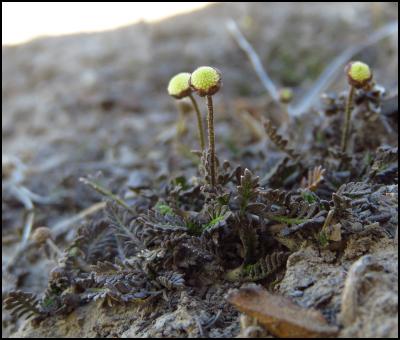‘Extinct’ native plants rediscovered
‘Extinct’ native plants rediscovered

Department of Conservation rangers have rediscovered a native herb that was believed extinct and another herb thought to be extinct in the wild.
Dysphania pusilla, or pygmy goosefoot, had been one of eight native plant species listed as extinct until its surprise rediscovery in summer. By coincidence it was found at two widely-separated sites within a couple of weeks – in Canterbury’s McKenzie Basin and in Molesworth Station in South Marlborough.
Another native herb, Leptinella filiformis, or slender button daisy, also found in Molesworth, hadn’t been seen growing wild since the late 1990s though it was being cultivated at some protected sites.
DOC Director-General Lou Sanson said these were remarkable rediscoveries and he commended the rangers for their work and observance in finding the species.
‘The last record of pygmy goosefoot was from 56 years ago and amazingly when rediscovered this year a few thousand plants were seen at both locations.
‘Botanists believe pygmy goosefoot may lie dormant for many years as seed when conditions aren’t suitable for it to grow. It was fortunate rangers were in the right places at the right time when it had germinated in abundance enabling its rediscovery.
‘Both herb species grow in dry, open areas and finding them highlights how much is still being learnt about the unique species that inhabit such dryland ecosystems and what is needed to preserve them.’
Nelson rangers Shannel Courtney and Simon Walls came across pygmy goosefoot in the Clarence River valley during a flora and fauna survey. Shannel, a botanist, recognised the species and realised the significance of the find.
Twizel ranger Aalbert Rebergen a short time later discovered pygmy goosefoot growing in the Ruataniwha wetlands and was mystified as to what species it was. Botanists he initially approached to identify the species suggested other plants. Aalbert was sure it wasn’t them and pursued identification, eventually getting confirmation it was Dysphania pusilla.
Pygmy goosefoot was also found in late March in the Heron Basin in mid-Canterbury by DOC botanist Nicholas Head.
The rediscovery of wild slender
button daisy was recently confirmed after plants rangers
collected in summer were grown on till they flowered,
enabling the species to be verified.
Wairau ranger Jan Clayton-Greene had seen the herb on an earlier visit to the remote Clarence valley area but at the time didn’t recognise the species. The wild plants looked scruffier than cultivated ones she had seen. A botanist later identified a specimen she had pressed and she returned with other rangers to collect some of the plants when river levels were low enough to allow access.
DOC staff are now determining what will be done to learn more about the herb species, the threats they face, and what measures may be needed to protect them.
–Ends–


 Business Canterbury: Urges Council To Cut Costs, Not Ambition For City
Business Canterbury: Urges Council To Cut Costs, Not Ambition For City Wellington Airport: On Track For Net Zero Emissions By 2028
Wellington Airport: On Track For Net Zero Emissions By 2028 Landcare Research: ANZAC Gall Fly Release Promises Natural Solution To Weed Threat
Landcare Research: ANZAC Gall Fly Release Promises Natural Solution To Weed Threat NZ Anti-Vivisection Society: Auckland Rat Lovers Unite!
NZ Anti-Vivisection Society: Auckland Rat Lovers Unite! University of Canterbury: $1.35 Million Grant To Study Lion-like Jumping Spiders
University of Canterbury: $1.35 Million Grant To Study Lion-like Jumping Spiders Federated Farmers: Government Ends War On Farming
Federated Farmers: Government Ends War On Farming



